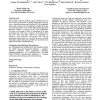Free Online Productivity Tools
i2Speak
i2Symbol
i2OCR
iTex2Img
iWeb2Print
iWeb2Shot
i2Type
iPdf2Split
iPdf2Merge
i2Bopomofo
i2Arabic
i2Style
i2Image
i2PDF
iLatex2Rtf
Sci2ools
CSCW
2006
ACM
2006
ACM
Moving office: inhabiting a dynamic building
Mixed Reality Architecture (MRA) supports distributed teams in their everyday work activities by linking multiple physical spaces across a shared three-dimensional virtual world. User configurable audio-visual connections give the inhabitants of MRA full control over whom they want to be in contact with and when they make themselves available, as well as over the overall configuration. We report on the design of MRA, its deployment in an office environment and results from a long-term observational study. The study shows that MRA supports the management of awareness, social interaction and privacy well, that the architectural design features are crucial for this process and that the dynamic architectural topology of MRA and social interaction within it are linked in a fundamental way. Categories and Subject Descriptors H.5.3 [INFORMATION INTERFACES AND PRESENTATION (e.g., HCI)]: Group and Organization Interfaces --- Computersupported cooperative work, Synchronous interaction, Evaluati...
Configurable Audio-visual Connections | CSCW 2006 | Mixed Reality Architecture | Social Interaction | Social Sciences |
| Added | 13 Jun 2010 |
| Updated | 13 Jun 2010 |
| Type | Conference |
| Year | 2006 |
| Where | CSCW |
| Authors | Holger Schnädelbach, Alan Penn, Phil Steadman, Steve Benford, Boriana Koleva, Tom Rodden |
Comments (0)

